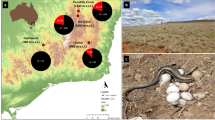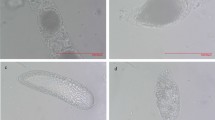Abstract
THE breeding of the barnacle Balanus balanoides (L.) is controlled by light and temperature; a temperature below a critical value of 10° C and a light periodicity of less than 12 h/day are necessary before the barnacle will breed 4–8 weeks later1. As part of the cyclic activity of the oviducal glands during the natural breeding phase of B. balanoides 2–3 weeks before fertilization an elastic sac is formed within each gland2 which envelops the eggs as they pass down the oviduct, forming a membrane binding the egg mass together.
This is a preview of subscription content, access via your institution
Access options
Subscribe to this journal
Receive 51 print issues and online access
$199.00 per year
only $3.90 per issue
Buy this article
- Purchase on Springer Link
- Instant access to full article PDF
Prices may be subject to local taxes which are calculated during checkout
Similar content being viewed by others
References
Barnes, H. J., J. Mar. Biol. Assoc. UK, 43, 717 (1963).
Walley, L. J., J. Mar. Biol. Assoc. UK, 45, 115 (1965).
Gwilliam, G. F., Biol. Bull., 129, 244 (1965).
Fahrenbach, W. H., Zeitschr. Zellforsch., 66, 233 (1965).
Williams, C. M., Biol. Bull., 110, 201 (1956).
Author information
Authors and Affiliations
Rights and permissions
About this article
Cite this article
TIGHE-FORD, D. Possible Mechanism for the Endocrine Control of Breeding in a Cirripede. Nature 216, 920–921 (1967). https://doi.org/10.1038/216920a0
Received:
Issue Date:
DOI: https://doi.org/10.1038/216920a0
This article is cited by
-
Living on the edge: reproductive cycle of a boreal barnacle at its southernmost distribution limit
Marine Biology (2021)
-
Types of diapause in Crustacea: definitions, distribution, evolution
Hydrobiologia (1996)
-
Laboratory rearing of barnacle larvae for antifouling research
Helgoländer Wissenschaftliche Meeresuntersuchungen (1970)
-
Environmental control of the breeding of three boreo-arctic cirripedes
Marine Biology (1969)
Comments
By submitting a comment you agree to abide by our Terms and Community Guidelines. If you find something abusive or that does not comply with our terms or guidelines please flag it as inappropriate.



